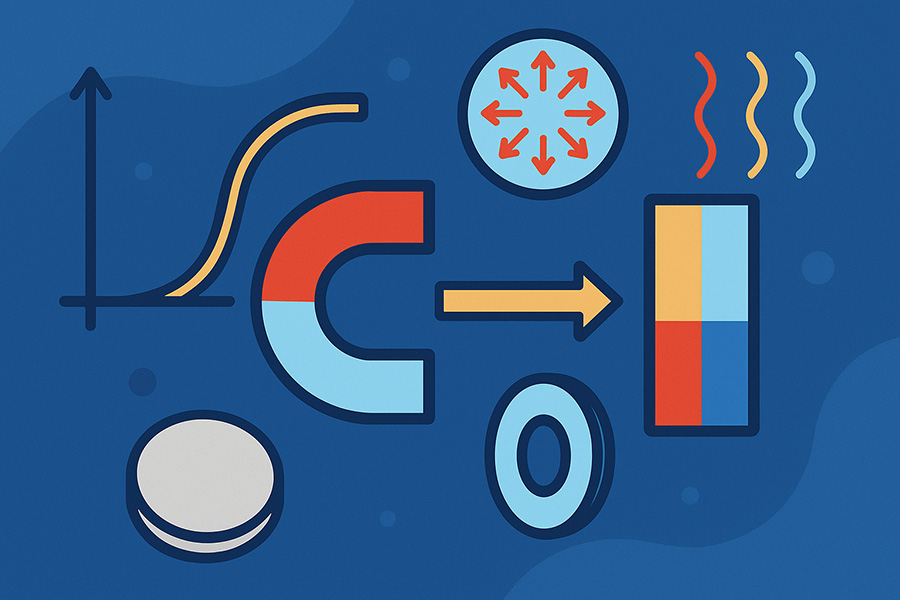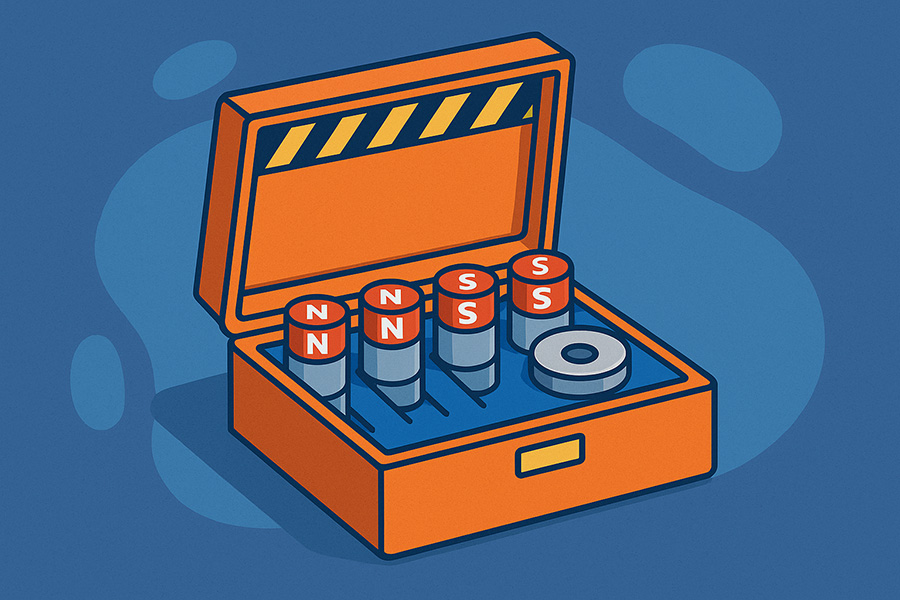Hey there, magnet users and enthusiasts!
Today, we’re diving deep into the world of magnet coercivity.
It may sound like a complex topic.
But don’t worry – I’ll break it down for you in a way that’s easy to understand.
We’ll cover everything from the basics of coercivity to its practical applications and measurement techniques.
So, let’s dive in!
1. What is Magnet Coercivity?
Magnet coercivity, also known as the coercive field or coercive force.
- A measure of a ferromagnetic material’s ability to resist demagnetization when exposed to an external magnetic field.
- In other words, it quantifies how difficult it is to demagnetize a magnetic material.
Coercivity is usually measured in oersted (Oe) or ampere/meter (A/m) units.
It is denoted as HC.
- To determine a material’s coercivity, we measure the strength of the material’s magnetic field when fully magnetized (B).
- And the strength of the opposing field required to reduce B to zero (H).
2. Types of Coercivity
There are different types of coercivity. It depends on the threshold for demagnetization:
- Normal Coercivity (HCn): The magnetic field required to reduce the magnetic flux to zero.
- Intrinsic Coercivity (HCi): The magnetic field required to reduce the magnetization to zero.
- Remanence Coercivity (HCr): The magnetic field required to reduce the remanence to zero.
Materials with high coercivity are called magnetically “hard”, and we use them to make permanent magnets.
Materials with low coercivity are magnetically “soft”.
3. Coercivity & Permanent Magnets
Coercivity has a significant impact on the performance and applications of permanent magnets:
Resistance to Demagnetization
Permanent magnets with high coercivity maintain their magnetic properties.
They are difficult to demagnetize.
- This makes them suitable for applications where a stable magnetic field is needed.
Magnetic Hardness
Hard magnetic materials are used to make permanent magnets that retain their magnetization.
Soft magnetic materials are used in applications with frequently changing magnetic fields.
Hysteresis Losses
Magnets with higher coercivity have wider hysteresis loops.
This indicates greater energy losses when the magnetic field is reversed.
It makes high coercivity magnets less suitable for applications with rapidly changing fields.
Temperature Stability
In NdFeB magnets, higher coercivity improves thermal stability.
This is important for applications at elevated temperatures.
However, their coercivity drops significantly at higher temperatures due to their low Curie point.
Remanence
High coercivity helps maintain a magnet’s remanence by resisting demagnetization.
4. Normal vs. Intrinsic Coercivity
The main differences between normal coercivity (Hcb) and intrinsic coercivity (Hcj) are:
Definition
- Hcb is the field strength required to reduce the magnetic flux density (B) to zero.
- Hcj is the field strength needed to reduce the magnetization (M) to zero.
Demagnetization Level
At Hcb, the demagnetization is recoverable if the magnet hasn’t been taken below the “knee” of the demagnetization curve.
At Hcj, the magnet’s polarization has been reduced to zero.
This represents a complete loss of magnetization.
Magnetic Configuration
Hcb describes the magnet in an open circuit configuration.
Hcj refers to the coercivity of a magnet material in a closed circuit configuration.
Relevance for Different Materials
The distinction between Hcb and Hcj is minimal in soft magnetic materials.
But it can be significant in hard magnets.
5. Temperature Effects on Coercivity
The coercivity of permanent magnets is significantly affected by temperature changes.
- In general, coercivity decreases as temperature increases.
But the extent and nature of this effect varies depending on the magnet material:
NdFeB Magnets
The coercivity of NdFeB magnets drops significantly as temperature rises.
This limits their high-temperature applications.
SmCo Magnets
SmCo magnets have a better temperature coefficient for coercivity compared to NdFeB.
They can maintain their magnetic properties up to 350°C.
Alnico Magnets
Alnico magnets have the highest maximum operating temperature among permanent magnets, up to 525°C for Alnico.
They have the greatest thermal stability.
- They lose only about 0.02% of their coercivity per °C rise in temperature.
Ferrite (Ceramic) Magnets
Ferrite magnets are unique.
Their intrinsic coercivity actually increases with temperature, by about 0.4% per °C.
6. Materials with the Highest Coercivity
The materials with the highest coercivity for permanent magnets are:
Tb-Fe-B alloys
Tb2Fe14B-based systems can achieve coercivities up to ~9 T for melt-spun ribbons.
And over 7 T for bulk magnets produced by vacuum suction casting.
Sm-Co alloys
Sm2Co17 and SmCo5 magnets can reach very high coercivities.
Some grades like Sm2Co17 225/200 have intrinsic coercivities of 1990 kA/m (25 kOe).
Nd-Fe-B alloys
Sintered NdFeB magnets can achieve intrinsic coercivities up to 2786 kA/m.
By substituting some of the Nd with heavy rare earths like Dy or Tb, the coercivity can be further increased.
L10 phase FePt
The tetragonal L10 phase of FePt exhibits very high magnetocrystalline anisotropy.
Coercivities exceeding 980 kA/m have been reported for FePt.
Some studies demonstrate coercivities over 5 T.
7. Measuring Coercivity in Practical Applications
Coercivity is typically measured in practical applications using the following methods:
Hysteresisgraph
Measures both the remanence and coercivity of a magnetic material by magnetizing and demagnetizing a test specimen.
It plots the hysteresis loop.
From this, the coercivity can be determined.
Vibrating Sample Magnetometer (VSM)
The sample is vibrated in a uniform magnetic field.
This induces a voltage in pickup coils proportional to the sample’s magnetic moment.
By varying the applied field, the hysteresis loop and coercivity can be determined.
Torque Magnetometer
Measures coercivity using a torque magnetometer.
The sample is saturated along its uniaxial orientation.
Then it is rotated by (180+δ) degrees.
The applied field value where the measured torque becomes zero represents the coercivity.
Coercive Force Meter
Instruments like the DX-320 Coercivity Measurement Instrument are suitable for measuring the coercivity of soft magnetic materials.
Open Circuit Measurement
Coercivity of magnetic materials is measured using a system appropriate for the material type (soft, hard, semi-hard).
The procedure involves saturating the sample.
Then reducing the field to zero.
And then applying a progressively increasing negative field until the magnetization becomes zero.
8. Intrinsic Coercivity & Temperature
Intrinsic coercivity has a significant impact on the reliability and performance of permanent magnets in high-temperature environments:
- Intrinsic coercivity decreases with increasing temperature in most permanent magnets.
- This means the magnet’s ability to resist demagnetization weakens at higher temperatures.
Sm-Co magnets
- Generally have better high-temperature performance compared to Nd-Fe-B.
- However, their intrinsic coercivity still drops sharply with increasing temperature. This limits reliability.
Nd-Fe-B magnets
- Their intrinsic coercivity decreases rapidly at higher temperatures due to their low Curie point.
- This limits their reliable operating temperature.
A high intrinsic coercivity is necessary.
But it is not always sufficient for good high-temperature performance.
Factors like the magnet’s microstructure, composition.
And the temperature dependence of saturation magnetization also play important roles.
Developing abnormal temperature dependence of coercivity is key for reliability in demanding high-temperature applications.
This is where intrinsic coercivity increases or remains stable with temperature.
9. Practical Applications
There are several practical applications where intrinsic coercivity (Hcj) is more critical than normal coercivity (Hcb):
High-temperature applications
In applications where permanent magnets operate at elevated temperatures.
- Like, in electric vehicle motors or generators, intrinsic coercivity is more important.
- It prevents irreversible loss of magnetization.
Magnets exposed to strong demagnetizing fields
In applications where magnets are subjected to strong opposing magnetic fields.
- For example, in magnetic couplings or Halbach arrays, intrinsic coercivity is more critical.
Closed-circuit magnetic configurations
In applications where magnets are used in closed-circuit configurations.
- Such as in magnetic bearings or magnetic gears, intrinsic coercivity is more relevant.
Applications using rare-earth magnets
In high-performance applications that utilize strong rare-earth magnets.
- NdFeB or SmCo, focusing on Hcj ensures that the magnet’s full demagnetization resistance is considered in the design.
10. Influence of Magnet Geometries
Different magnet geometries can significantly influence both the normal coercivity (Hcb) and intrinsic coercivity (Hcj) of permanent magnets:
Length to diameter ratio (L/D)
Magnets with higher L/D ratios have higher coercivity values.
This is due to better resistance to self-demagnetization, elevated temperatures, and external demagnetizing fields.
Permeance coefficient (Pc)
Magnets with higher Pc values have greater resistance to demagnetization.
Demagnetizing field
Elongated shapes (high L/D) have weaker demagnetizing fields compared to flat or wide shapes (low L/D).
Flux concentration
Shapes with sharp corners or edges can lead to localized flux concentrations that exceed the magnet’s coercivity.
This causes irreversible demagnetization in those regions.
Anisotropy
Aligning the magnet’s shape with its easy axis of magnetization (high anisotropy direction) enhances its coercivity and resistance to demagnetization.
Surface effects
Geometries with a large surface area to volume ratio (thin films, powders) have lower coercivity compared to bulk magnets.
11. Common Methods to Measure Coercivity
There are several common methods used to measure coercivity in different types of magnetic materials:
Hysteresisgraph or Hysteresis Loop Tracer
Measures both remanence and coercivity by magnetizing and demagnetizing a test specimen.
Commonly used for hard and semi-hard magnetic materials.
Vibrating Sample Magnetometer (VSM)
The sample is vibrated in a uniform magnetic field.
The hysteresis loop and coercivity can be determined by varying the applied field.
Suitable for a wide range of magnetic materials.
Alternating Gradient Magnetometer (AGM)
Similar to VSM, but uses an alternating gradient field instead of sample vibration.
Measures the hysteresis loop and coercivity by varying the applied field.
Superconducting Quantum Interference Device (SQUID) Magnetometer
Highly sensitive magnetometer used for measuring coercivity in thin films and small samples.
Pump-Probe Atomic Magnetometer
Experimental technique for measuring coercivity of soft magnetic materials in an open magnetic circuit using a rubidium atomic magnetometer to detect changes in magnetization.
Hall Effect Sensor or Gaussmeter
Measures the magnetic field strength directly using a Hall probe.
Can be used to measure the hysteresis loop and coercivity of soft magnetic materials in an open magnetic circuit.
Torque Magnetometer
Measures the magnetic torque experienced by a sample in a rotating magnetic field.
Can determine the coercivity by analyzing the torque curve.
12. Differences in Measurement Process
The measurement process for coercivity differs between soft, hard, and semi-hard magnetic materials in the following ways:
Measurement system
The choice of measurement system depends on the type of magnetic material.
- Soft magnetic materials can be measured using open samples.
- Hysteresigraphs are particularly desirable for testing semi-hard and hard magnetic materials.
Saturating field strength
The level of excitation needed to saturate the material before measuring coercivity depends on the expected coercivity value.
Soft materials require a lower saturating field compared to hard materials.
Measurement range
The equipment and procedures described in ASTM A773/A773M are most suited for soft and semi-hard materials with intrinsic coercivity less than about 100 Oe (8 kA/m).
Materials with higher intrinsic coercivities should be tested according to ASTM A977/A977M.
Demagnetization process
After saturation, the material is brought to remanence by reducing the field to zero.
Then, a negative field is progressively applied until the magnetization becomes zero.
This represents the coercivity.
The negative field required is relatively low for soft materials and much stronger for hard materials.
Measurement of remanence coercivity
Determining the remanence coercivity is more complicated.
It involves switching the applied field back to zero and checking if the remnant magnetization is zero.
This process may need to be repeated with different levels of negative field for hard materials.
Wrapping Up
Wow, that was quite a journey through the world of magnet coercivity!
I hope this comprehensive guide has helped you understand the importance of this property.
And how it affects a magnet’s performance in various applications.
If you have any questions, feel free to reach out.



